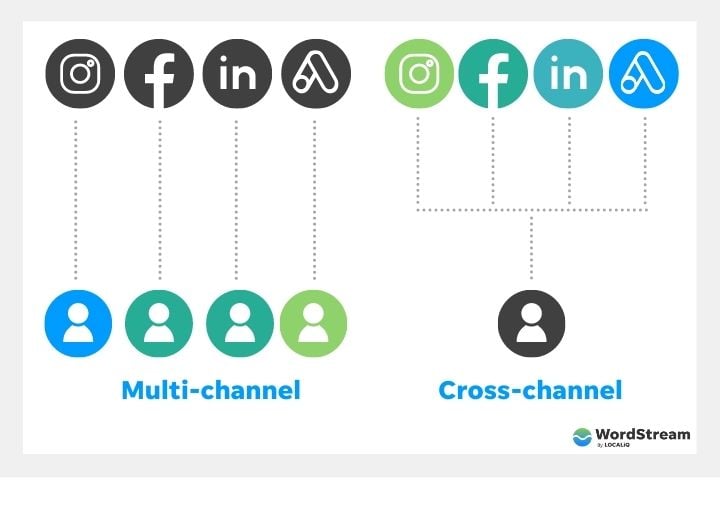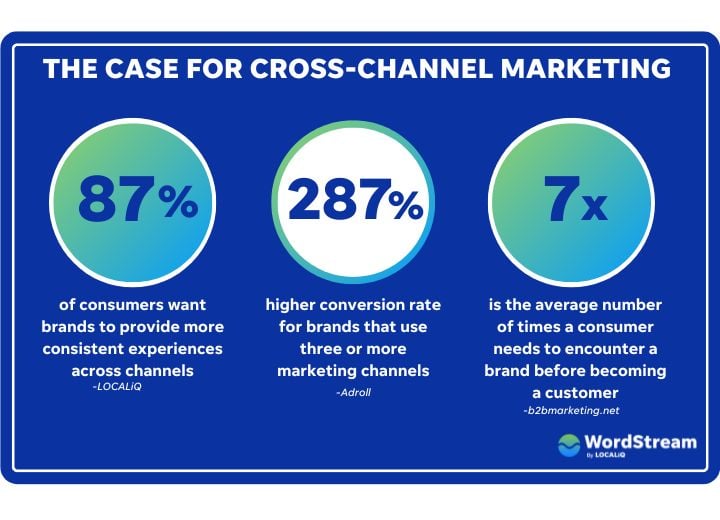Unless you went to clown college (props to you if you did), you probably struggle to pull off the classic “juggling act” of marketing your business as much as possible.

Marketing your business can sometimes feel like this.
However, it doesn’t always have to feel like you’re performing tricks to market your business successfully across the board. Today, I’m going to show you how you can market your business for maximized success without jumping through hoops. The secret is cross-channel marketing. Now, just hearing that word may raise some questions—which I’ll provide the answers to, like:
Let’s jump right in!
Cross-channel marketing guide table of contents
- What is cross-channel marketing?
- The difference between cross-channel and multi-channel marketing.
- How to know if cross-channel marketing is right for you.
- Benefits of cross-channel marketing.
- The right number of channels in cross-channel marketing.
- How to implement your own cross-channel marketing strategy.
What is cross-channel marketing?
In order to understand cross-channel marketing, you first have to be familiar with marketing channels—which are all the various places you could promote your business both online and offline. You may be using more channels than you think, as any time you communicate with your target audience is an opportunity to market your brand. This means that anything like radio advertising placements, live chat on your website, your social media platforms, online search ads, and more could all be considered marketing channels.
Cross-channel marketing means you’re leveraging multiple placements, platforms, or other forms of communication to promote your brand holistically across your sales funnel. It focuses on the customer journey—meaning you’re customizing your offers on each channel to their stage in the funnel. It takes your marketing a step further where you’re not only using multiple marketing channels, but also making sure each of them align to create a seamless, customer-centric marketing experience.
What’s the difference between cross-channel and multi-channel marketing?
Cross-channel marketing often gets confused with multi-channel marketing, so here’s a quick breakdown:
With multi-channel marketing, you use multiple channels to reach your customer but the channels don’t share information with one another. You may still be maintaining brand consistency across channels, but your offers may not always align with where the customer is at in their journey.
Example
Let’s say you’re an IT provider. A person searches on Google for cloud migration and sees a search ad for your services. They click it and go to your site but exit. Later, they go on Facebook where they see an ad for your services, but they don’t click it. The following week, they go on LinkedIn where they see an ad to download your enterprise benchmarks report.
With cross-channel marketing, the multiple channels do share information with one another, so the offer a person sees on any given channel is determined by their previous engagement with your business (on any other channel).
Example
So, let’s redo the IT provider example in a cross-channel setting. A person searches on Google for cloud migration and sees a search ad for your services. They click it and go to your site but exit. Later, when they go on Facebook, they see a lead ad for a guide on cloud migration, which they download. In the lead form, they indicate their company size . The following week, when they’re on LinkedIn, they see an ad for a webinar on 10 IT mistakes small businesses make. They register and when they attend, they sign up for a consult.
See the difference? In the cross-channel strategy, you have curated material that meets your customers’ needs across their journey. This means that, while a multi-channel marketing strategy is important, you’ll ideally want some of those channels to be involved in a cross-channel system.
Is cross-channel marketing right for you?
Just as marketing on one channel is better than on no channels, and multi-channel marketing is better than single-channel, cross-channel marketing is ultimately better than multi-channel. It’s right for you if…
You want to maximize your results. Since cross-channel marketing involves customizing your offers to a person’s stage in the funnel, their chances of conversion at each of those points is much higher. Plus, this personalized approach helps to make your brand more memorable and increases your chances of turning prospects into customers.
You’re tight on time. You read that right! Many people think cross-channel marketing takes a ton of time. But when you unify your efforts across platforms, you can streamline processes like asset creation and reporting.
You’re tight on budget. Don’t put all your eggs in one basket. If you’re tight on budget you’ll want plenty of opportunities to squeeze the most out of it across platforms, rather than spending it all on one with no results.
You have a busy audience. Most people are bouncing around many places across the web, with cross-channel marketing you’re catching your audience at every step of the sales funnel.
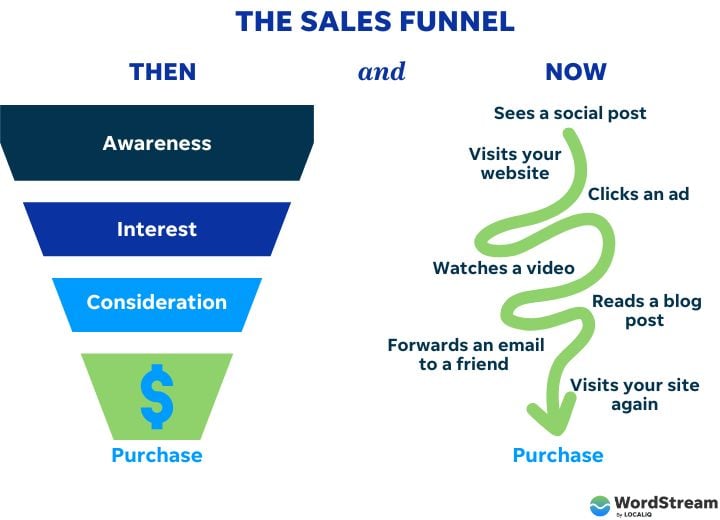
Cross-channel marketing helps you meet the needs of the ever-changing sales funnel.
Benefits of cross-channel marketing
While we touched on some of the pros to cross-channel marketing above, you may also want to consider these statistics when deciding if this strategy is right for you:
- The average consumer needs to interact with a brand at least seven times before they become a customer. Cross-channel marketing helps you to make each of those encounters super-relevant, potentially even reducing the number of encounters needed..
- 87% of consumers want brands to provide more consistent experiences. With multi-channel marketing, your content is siloed for each platform. Whereas with cross-channel marketing, you’ll be able to provide a seamless brand experience throughout the buyer’s journey.
- Brands using three or more marketing channels see a 287% higher conversion rate.
- Businesses that engage with people across multiple channels see nearly 90% of their customers returning for more later. This means that cross-channel marketing can increase your brand loyalty over time.
Clearly, cross-channel marketing is a non-negotiable when it comes to reaching your marketing goals.
How many channels should your cross-channel marketing include?
A question I often get asked is, “How many channels are enough channels?” This question is completely valid, as most brands are looking to squeeze the most out of limited resources, though you probably can guess what I’m about to say: there is no right or wrong answer.
Giving a set blanket number of channels for all business types wouldn’t make sense, as each organization has a unique set of goals and challenges. What it really comes down to is how able you are to connect those channels with one another and integrate them into your marketing system.
Even still, you might have multi-channel efforts happening alongside your cross-channel efforts—as it’s not be possible to connect every single channel and effort. So if you’re not sure how many ad channels to use, here are some things to consider:
Budget
Your marketing budget will determine how much or how little you may be able to put towards each of your desired channels.
This is not to say that those with monster marketing budgets should be blasting themselves across as many channels as possible, or that lower budget marketing equates to fewer channels. Think more about how you’ll allocate budget towards each channel depending on your needs.
If you need help calculating this, we have plenty of resources on it like this post on creating your marketing budget. However, a good rule of thumb is that 5-10% of your revenue should go towards your marketing budget. For larger businesses, that number could climb to 14% or higher.
Audience
Picture your ideal customer when you’re picking your channels. How many channels do they use? What does their day-to-day lifestyle look like? Where do they live, and how old are they?
Asking yourself exploratory questions like this about your audience can help you determine how many channels you need in order to effectively reach them at each step of the way.
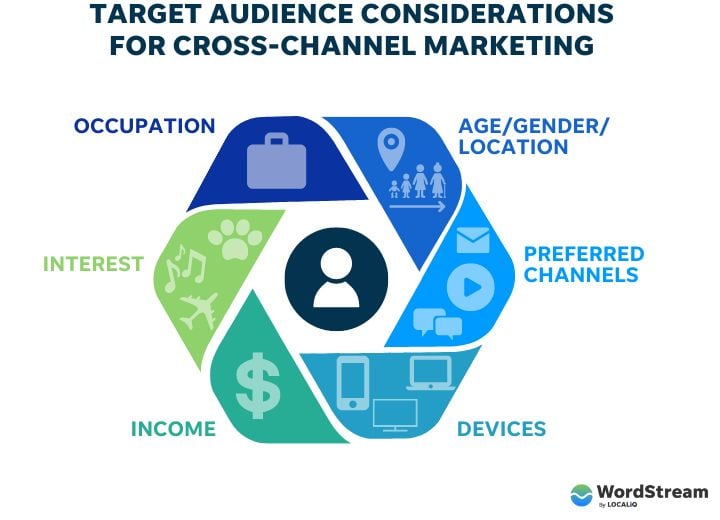
Goals
Your business’s marketing objectives will also impact how many channels you choose. For example, if you’re looking to increase your online presence, you may need to add social media as an additional channel for your strategy—even if you’ve never tried it before.
Resources
Time will also be a factor because, at the end of the day, one individual or team can only do so much. However, you may have other tools at hand that can make cross-channel management easier.
See if you might have a way to summarize your reporting across channels, or if there are any platforms you can use to send out multiple marketing assets at once. These time-saving tools can help you to do more with less.
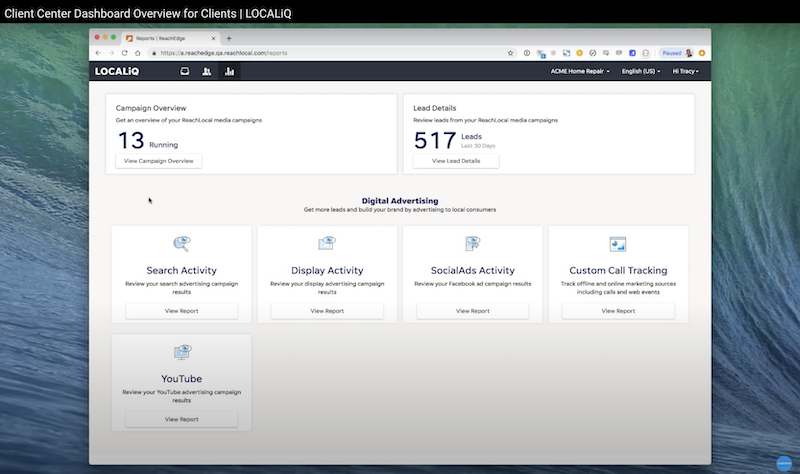
CRMs like LOCALiQ’s Client Center allow you to streamline reporting on many platforms with one dashboard.
As you can imagine, answers to the above are going to look different for everyone. If you’re still stuck and need a number of channels to start with, here’s what I’ll say: pick your top three. This will allow you to still be using multiple channels to see what works, as opposed to only using one or two, and you can always add on from there.
How to create a cross-channel marketing strategy
You might be wondering: is cross-channel marketing easy to achieve? Short answer: yes. You can do it all! Here are our ten tips to finding cross-channel marketing success for your business:
1. Map out your customer journey
Before you dive into cross-channel marketing, it’s important to get a bird’s eye view of your sales funnel. Understanding your consumers’ behavior at each step of the buyer’s journey will help you to identify which offers best align with each stage.
Look at historical data and information your business may have on how past customers may have converted. You could also leverage your audience analysis to put yourself in your customers’ shoes and brainstorm the steps they may take to ultimately commit to your business.
Not only will this help you tailor your cross-channel marketing to specific scenarios throughout the customer journey, but it will also help you to narrow down which channels are best (more on this next).
2. Have an offer funnel
The key to cross-channel marketing is aligning your offers with each stage of the funnel. Someone at the top of your funnel is more likely to be open to a guide on how to do something than a demo on how to use your product. Or even within the guide category, they may be more receptive to a high-level overview on something than a more technical one on ways to do it.
So be sure to map out different offers and topics to the stages of your customer journey. This will look different for every business, but here’s a loose example:
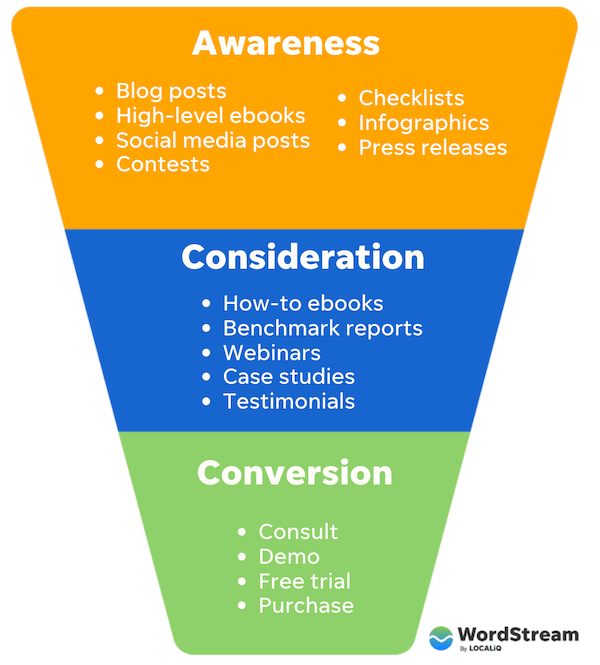
3. Choose your channels
Using our guidelines above may have helped you narrow down the number of channels you’ll be looking to use, so now it’s a matter of which channels. Here at WordStream, we believe in working smarter, not harder. Your best bet would be to pick channels that will work better together to maximize your results.
For example, search marketing and social media marketing complement one another. When someone sees your posts pop up on social, that may trigger them to search for you later to learn more.
Think back to your ideal buyer persona to understand which channels they may be hitting the most frequently, and that should help you uncover which ones are best for your business.
To help get you started, here are some possible channels to consider:
- Website
- SEO
- PPC
- Social media marketing
- Social media advertising
- Display advertising
- Remarketing
- Print ads
- Email marketing
- Mailers
- Geofencing
- Live chat
- Messaging apps
- OTT advertising
- Video marketing
- Content marketing
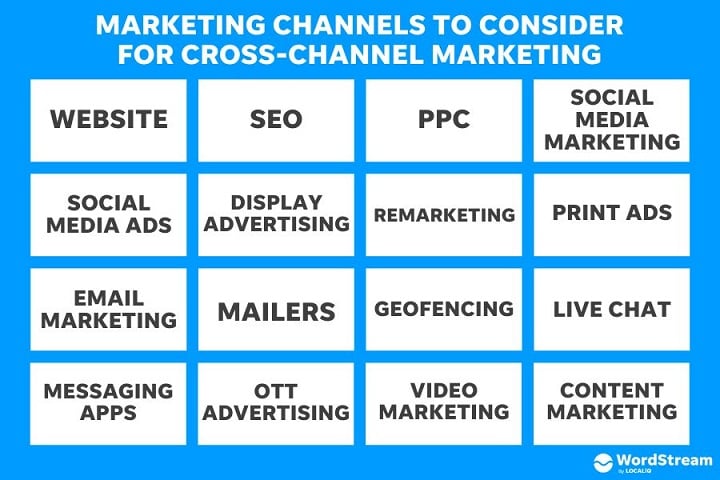
4. Take inventory of your costs
Be ready to be flexible with your budget as you implement cross-channel marketing. The performance of your channels might ebb and flow, so you may need to reallocate your budgets accordingly.
To help you get a sense of how much to spend on each channel, use industry benchmarks to estimate costs. Check in on these reports frequently to troubleshoot your spend or to see how your business stacks up throughout your marketing journey.
Using industry benchmarks like these can help you keep your cross-channel budget in check.
5. Have a set of overarching goals
While each channel may achieve different things, having a couple of “big picture” goals can help you to unify your efforts. It can be easy to get bogged down in the deep performance details of each channel. Overarching goals help to hold yourself accountable for keeping your channels on track for success.
6. Use a CRM
A customer relationship management (CRM) tool can work wonders for your cross-channel marketing. As your prospects’ behavior evolves, a CRM will allow you to track those changes and recognize broader trends in the customer journey. It will also make it easy for you to segment your campaign audiences so you can customize your offers.
CRMs can also make major cross-channel initiatives, like retargeting, a breeze.
7. Use retargeting
Speaking of which, retargeting is a must-have for any cross-channel marketing strategy. There are a number of retargeting audiences you can try out. For example, you might run a retargeting Facebook ad for a product that someone added to their cart but did not purchase. Or you might run a specific promotion for your most loyal customers.
8. Button up your tracking
Be sure you implement tracking parameters across every channel you leverage in your cross-channel marketing strategy. Not only will this allow you to see how each channel, offer, and placement is working, but it will also allow you to set rules in your marketing automation. For example, if a person downloads guide X, show them thank you page A with offer B.
The naming convention you use for tracking is completely up to you—what’s most important is you have an easy and reliable way to consistently know how your performance is pacing across channels.
And on a related note, make sure you resolve all your conversion tracking hangups for search engine marketing as this can make or break your campaigns.
9. Use multi-touch attribution
Attribution modeling determines how the different channels involved in a customer’s journey will be credited.
For cross-channel marketing, it’s best to go with one that falls under the multi-touch attribution umbrella. Since you’ll be encouraging customers to take specific actions across channels, you’ll want to see the impact your campaigns have on the entire customer journey. Multi-touch attribution modeling helps you to do so by using data across channels to weight certain actions more than others.
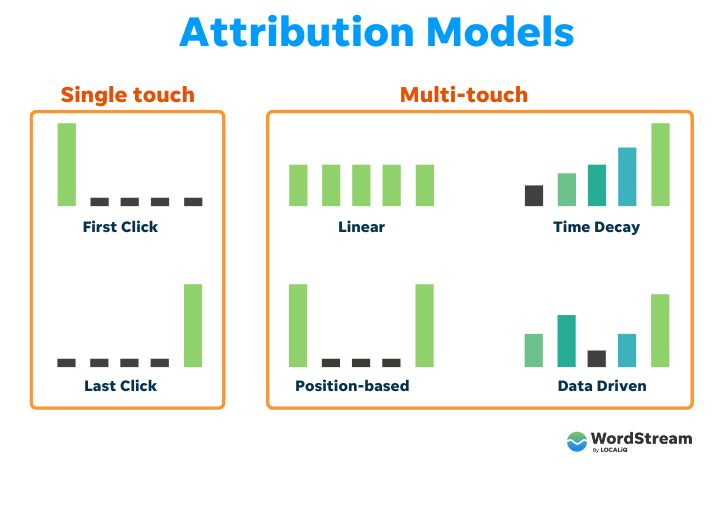
10. Keep your reporting all in one place
To make cross-channel marketing more manageable and effective, unify your reporting efforts. Use free tools like Google Analytics to understand how your platforms are performing in one space. Not only does this save you time, but it also helps you to understand how all your channels are performing both against and in concert one another.
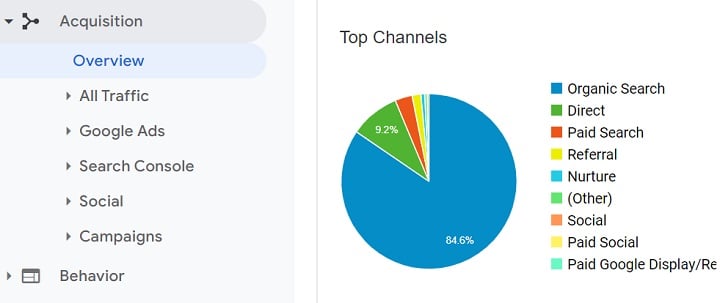
Here is one example of how Google Analytics displays success by channel in multiple different ways.
11. Try nurture email campaigns
While it’s great you have cross-channel materials at the ready to move customers along in their journey, some people may need a bit more of a nudge than others.
Targeted email marketing is a great go-to for this situation since you can segment out your lists and offers accordingly. You could even automate your emails to send once someone completes a specific step in your funnel.
This is an easy default strategy to boost your cross-channel marketing and keep customers engaged.
12. Be patient
The hardest part of cross-channel marketing is patience! Some channels may bring you results more quickly than others. This is precisely why choosing a variety of channels is so important.
One channel, PPC advertising, may help you reach your business’s short-term goals while others, like local SEO, will bring you results in the long term. Treating your cross-channel marketing like a living, breathing project that’s ongoing will help you to set realistic expectations and make the most of your results along the way.
Cross-channel marketing is easier than you think
Many don’t consider successful cross-channel marketing feasible for their business. However, this complete cross-channel marketing guide proves that it can be a viable strategy for anyone. With a bit of self-evaluation, patience, and the help of online tools or platforms, your cross-channel marketing strategy can help you to gain and retain customers for sustainable business growth.
To recap, here is how to do cross-channel marketing effectively:
- Map out your customer journey
- Choose your channels
- Prep your content ahead of time
- Take inventory of your costs
- Have a set of overarching goals
- Use a CRM
- Use retargeting
- Button up your tracking
- Use multi-touch attribution
- Keep your reporting all in one place
- Try nurture email campaigns
- Be patient

